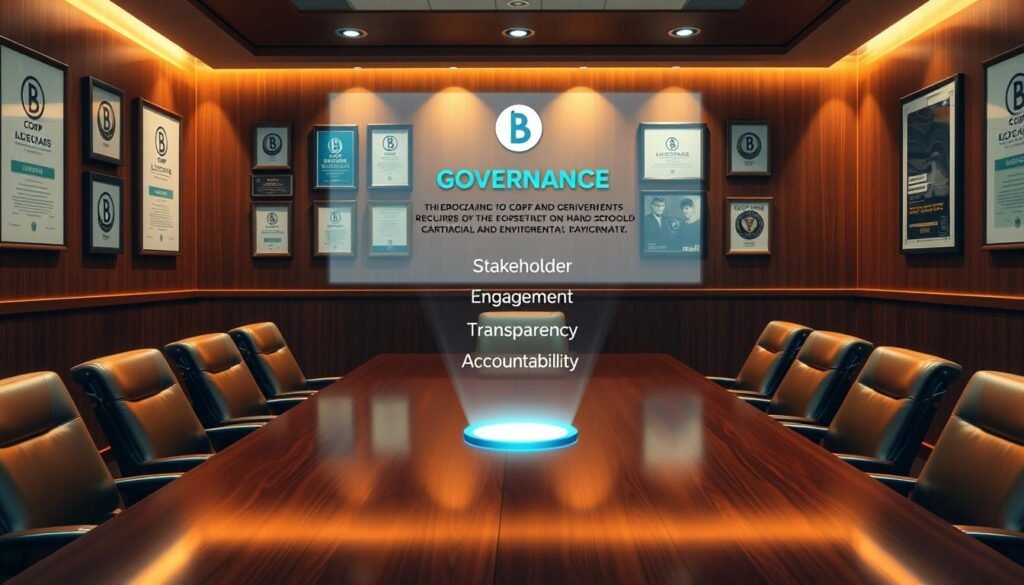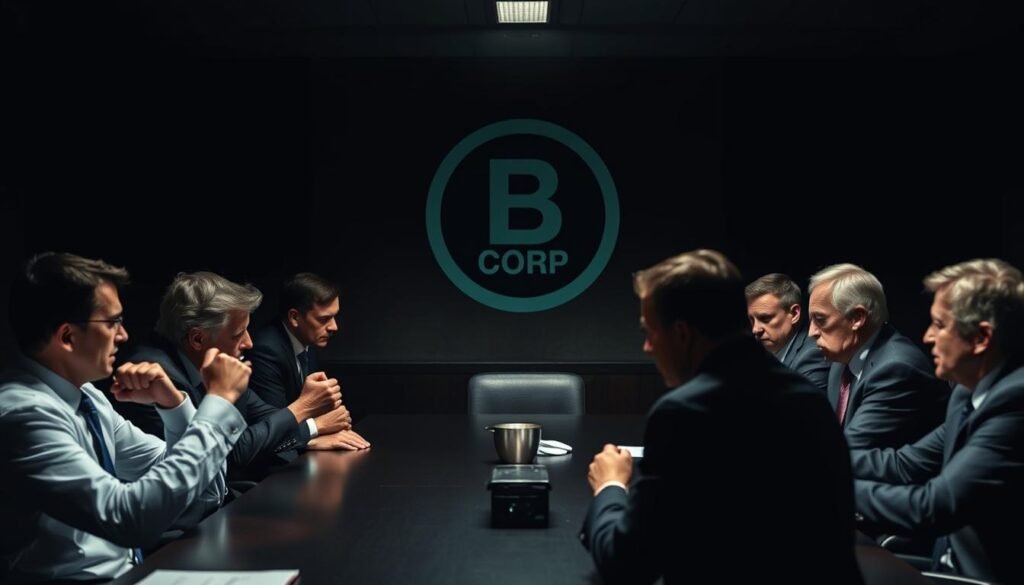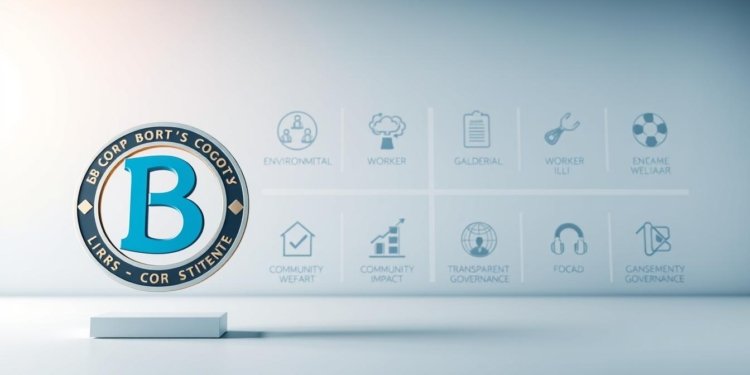What if your favorite company wasn’t just focused on profits, but measured success by its positive impact on people and the planet?
This powerful question lies at the heart of the B Corporation movement. These businesses meet the highest verified standards of social and environmental performance.
B Lab, a global nonprofit, awards this certification to companies that score at least 80 on their rigorous assessment. This evaluation examines a company’s entire operations and governance.
The movement has grown tremendously, with nearly 10,000 certified businesses across 102 countries as of 2025. These organizations represent a shift toward more responsible capitalism.
Maintaining certification requires recertification every three years and ongoing transparency. This guide will help you understand the standards, process, and significance behind this global movement.
Key Takeaways
- B Corp certification represents the highest standard for socially responsible businesses
- Certification requires a minimum score of 80 on B Lab’s comprehensive assessment
- Nearly 10,000 companies worldwide have achieved this certification as of 2025
- Recertification is required every three years to maintain status
- The certification evaluates a company’s entire operations and impact
- B Corps are different from benefit corporations, which is a legal status
- The movement promotes businesses that balance purpose and profit
What Is a B Corp? Understanding the Certification
Imagine a business world where success means more than just financial gains. This vision drives the certification movement for socially conscious companies.
Definition and Purpose of B Corp Certification
This certification represents a private standard administered by B Lab. It signals a company’s dedication to social and environmental excellence.
The purpose goes beyond profit. Organizations aim to balance earnings with public benefit. They consider stakeholder interests in their operations.
Certification covers the entire company across all operations. It examines governance, workers, community impact, environmental practices, and customer relations.
B Lab’s Role in the B Corp Movement
B Lab serves as the certifying body for this global network. This nonprofit organization sets rigorous standards and conducts thorough assessments.
Since 2006, they have certified over 9,000 companies worldwide. They charge fees based on company revenue for both initial certification and recertification.
The standards evolve through periodic updates and public consultation. This maintains relevance and rigor in the certification process.
B Lab provides support throughout the journey. They offer access to a community of like-minded businesses committed to positive impact.
This certification creates transparency and credibility for consumers and investors. It demonstrates a genuine commitment to responsible business practices.
Unlike benefit corporations, this certification represents a voluntary designation rather than a legal status. Companies choose to meet these higher standards of accountability.
B Corp vs. Benefit Corporation: Key Differences
Many people confuse these two concepts despite their distinct purposes and frameworks. Understanding their differences helps businesses choose the right path for their social responsibility goals.
Legal Status and Legislative Framework
A benefit corporation represents a specific legal structure created by state legislation. This status exists in 35 states across the United States.
Delaware offers one prominent example of this corporate framework. Companies incorporated there can choose this legal designation.
This structure legally requires corporations to consider stakeholder interests. Shareholders can hold directors accountable for these commitments.
Certification Requirements vs. Legal Structure
The certification involves meeting performance standards set by a nonprofit organization. It focuses on measurable social and environmental impact.
Companies pursuing this certification must amend their governing documents. These changes commit the organization to consider its broader purpose beyond profit.
These amendments vary depending on state requirements and lack uniform legal enforcement. The certification itself does not create legal liability for companies.
Businesses can obtain both designations independently. One does not require or guarantee the other.
The certification operates globally across various countries. The legal status remains primarily an American concept.
Choosing between these options depends on a company’s specific goals. Some organizations pursue both to demonstrate comprehensive commitment.
The B Corp Certification Process
Companies seeking to demonstrate their commitment to stakeholders must complete a detailed performance review. This rigorous evaluation ensures organizations meet high standards for social and environmental responsibility.
The journey involves multiple steps with specific requirements. Each phase contributes to the overall credibility of the certification.
Completing the B Impact Assessment
Organizations begin with a free online tool that measures social and environmental performance. This comprehensive assessment evaluates five key areas: governance, workers, community, environment, and customers.
The system automatically adjusts questions based on industry, size, and location. Manufacturing companies receive heavier weighting on environmental impact questions.
Scoring at least 80 out of 200 points is mandatory to proceed. This threshold ensures only high-performing companies advance in the process.
Verification and Review by B Lab
Staff members conduct thorough reviews of all assessment submissions. They request supporting documentation to verify claims and data accuracy.
Background checks and randomized site visits add another layer of validation. This ensures complete transparency throughout the evaluation.
The assessment framework evolves every three years through public consultation. Version 6 launched in 2019, with Version 7 planned for future implementation.
Most companies complete the entire process within approximately 12 months. This timeframe applies to organizations operating for more than one year.
Successful applicants must sign a term sheet agreeing to ongoing requirements. This commitment maintains the integrity of the certification standards.
Recertification occurs every three years to ensure continued compliance. The $150 application fee supports the administrative costs of this rigorous review process.
Meeting B Corp Standards: Requirements and Commitments
Organizations pursuing this verified status must navigate a structured framework of accountability measures and ongoing commitments. The process involves both immediate operational changes and long-term organizational promises.
Integrating Stakeholder Interests into Governance
Companies must formally amend their governing documents to commit to stakeholder consideration. This includes articles of incorporation and other foundational legal papers.
The definition of stakeholders is intentionally broad and comprehensive. It includes employees, community members, the environment, suppliers, customers, and shareholders.
No single group receives automatic priority over others in this balanced approach. The framework ensures equal consideration across all stakeholder categories.
These governance changes help preserve the company’s social mission through leadership transitions. New management must maintain the same commitment to stakeholder values.
Specific legal requirements vary by state of incorporation. Some jurisdictions mandate benefit corporation status for full compliance with these standards.

Transparency and Recertification Every Three Years
Certified organizations must publicly disclose their social and environmental impact. This transparency requirement builds trust with consumers and investors.
While impact reports are public, internal company bylaws can remain confidential. This balance protects sensitive operational information.
The performance standards lack legal enforcement mechanisms. Leadership faces no liability for failing to meet these voluntary commitments.
Recertification occurs every three years to maintain certified status. Companies must complete updated assessments and verification processes.
This requirement applies even after ownership changes or public offerings. The three-year cycle ensures continued adherence to evolving standards.
Meeting these requirements represents an ongoing commitment rather than a one-time achievement. The framework drives continuous improvement in social responsibility.
Advantages of Becoming a Certified B Corp
Companies that achieve this certification unlock numerous advantages beyond traditional business success. These benefits span operational efficiency, talent attraction, and market positioning.
Enhancing Social and Environmental Responsibility
Certification holds organizations accountable to high standards of social and environmental performance. The assessment process identifies areas for improvement across all operations.
This framework encourages continuous positive change. Companies must demonstrate measurable impact through their business practices.
The recertification process every three years ensures ongoing commitment to these values. Organizations cannot rest on past achievements.
Many companies discover cost savings through efficiency improvements identified during assessment. The certification process helps eliminate wasteful practices.
Access to community data and best practices from other certified organizations provides valuable insights. This knowledge sharing accelerates positive change.
Attracting Talent and Building Consumer Trust
Certified companies attract like-minded employees who value purpose-driven work. Surveys show exceptionally high employee satisfaction rates among these organizations.
Room & Board demonstrates this impact with 90% employee pride in their certification. This validated culture helps retain top talent.
Consumers increasingly prefer sustainable companies with verified credentials. Third-party certification reduces greenwashing concerns and builds trust.
This status differentiates organizations in competitive markets by appealing to ethically conscious customers. The certification serves as a recognizable mark of credibility.
Economic benefits include access to discounts and services from other certified businesses and partners. These relationships create additional value for members.
The global community offers networking, collaboration, and knowledge-sharing opportunities. This support system fosters innovation and continuous improvement.
Criticisms and Controversies Surrounding B Corps
While the certification represents a significant step toward responsible business, it faces important questions about its effectiveness and integrity. These challenges highlight areas where the system must evolve to maintain credibility.

Concerns About Greenwashing and Legal Enforcement
Some certified companies face accusations of greenwashing. Nespresso maintained its status despite low recycling rates for its coffee capsules.
This created public skepticism about the certification’s rigor. Critics argue some organizations use the label for marketing without meaningful change.
The standards lack legal enforcement mechanisms. Companies face no liability for failing to meet their commitments.
This voluntary framework relies on self-reported data. Without legal consequences, accountability depends on organizational ethics.
The fee structure based on company revenue also draws criticism. Some argue it creates perverse incentives favoring larger corporations.
Notable Cases of Decertification and Public Scrutiny
Several high-profile cases demonstrate the certification’s enforcement challenges. BrewDog lost its status in 2022 after accusations of a toxic workplace culture.
This showed the system’s responsiveness to public pressure. The evaluation process identified cultural issues requiring action.
Havas agencies lost certification in 2024 for working with Shell. This highlighted conflicts between client choices and sustainability standards.
Dr. Bronner’s made headlines in 2025 by voluntarily dropping its certification. The company cited weakened standards that enabled greenwashing.
These cases reveal ongoing tension between ideals and implementation. They show the difficulty of maintaining consistent standards across diverse industries.
Additional criticism focuses on the lack of international accreditation. The standards don’t align with global frameworks, creating potential metric fragmentation.
Some studies question the certification’s contribution to UN Sustainable Development Goals. These controversies emphasize the need for continuous improvement in transparency and rigor.
Well-Known B Corp Examples and Their Impact
Leading companies across various industries demonstrate how certification transforms business practices. These organizations prove that profit and purpose can successfully coexist.
Their stories inspire other firms to pursue meaningful change. Each company shows unique approaches to social responsibility.
Case Studies: Ben & Jerry’s, TOMS, and Uncommon Goods
Ben & Jerry’s earned certification in 2012. The ice cream maker focuses on sustainable sourcing and social advocacy.
Their business model prioritizes fair trade ingredients and environmental stewardship. They demonstrate how large corporations can align with rigorous standards.
TOMS joined the movement in 2018. Their innovative model donates one-third of profits to mental health and other causes.
In 2023 alone, they contributed over $1.7 million to community programs. This shows deep integration of philanthropy into core operations.
Uncommon Goods maintains certification since 2007. Their Better to Give program supports numerous nonprofits.
This initiative has donated over $3 million to charitable organizations. The company exemplifies long-term commitment to social values.
These diverse examples prove certification works across industries. From ice cream to retail to manufacturing, any business can achieve this status.
Global Adoption and Growth of the B Corp Community
The movement now includes over 9,000 certified businesses across 102 countries. This represents tremendous growth in responsible business practices.
Significant concentrations exist in the United Kingdom with 3,144 companies. France follows with 1,232 certified organizations.
Canada shows strong participation with 1,079 certified businesses. Australia also demonstrates substantial engagement with the standards.
Sistema B adapts the framework for Latin American countries. This organization helps firms in Argentina and Brazil achieve certification.
Certified companies collectively employ over 848,000 workers worldwide. Their practices positively impact local and global communities.
This growth reflects increasing business interest in balancing profit with purpose. More organizations recognize the value of verified social responsibility.
The movement continues expanding as companies seek meaningful ways to serve stakeholders. Certification helps build consumer trust and attract talented employees.
Conclusion
This guide has shown how certification transforms companies into forces for good. The movement balances profit with positive impact through verified standards.
Businesses must weigh advantages like consumer trust against challenges like greenwashing risks. The process requires ongoing commitment through regular recertification.
Over 9,000 companies worldwide demonstrate this model works across industries. Their success proves business can drive meaningful change.
Consider if this path aligns with your company’s values and goals. The future promises evolving standards that will shape more responsible capitalism.
FAQ
What exactly is a B Corp?
A B Corp is a for-profit company that has been certified by the nonprofit B Lab for meeting high standards of verified social and environmental performance, public transparency, and legal accountability to balance profit and purpose.
How is a B Corp different from a benefit corporation?
The key difference is that B Corp is a certification awarded by B Lab, while a benefit corporation is a legal status created by state law. A company can be one, both, or neither. The certification involves a rigorous performance assessment, whereas the legal structure changes a company’s governance to consider stakeholders, not just shareholders.
What is the B Impact Assessment?
The B Impact Assessment (BIA) is a free, confidential digital tool provided by B Lab. Companies use it to measure their impact on their workers, community, customers, and the environment. A minimum verified score is required to achieve certification.
How long does B Corp certification last?
Certification is valid for three years. To maintain their status, companies must complete the verification process again, demonstrating improved or maintained performance standards, and pay a recurring fee.
Can any type of business become a B Corp?
Yes, any for-profit business entity, regardless of its size, sector, or ownership structure, can pursue certification. This includes multinational corporations, small family-owned businesses, and startups, provided they meet the performance requirements.
What are the main benefits of certification?
Key advantages include differentiating your brand in the marketplace, attracting and retaining mission-aligned employees, building deeper trust with consumers, and joining a global community of leaders dedicated to using business as a force for good.
Has the B Corp movement faced any criticism?
Yes, some criticisms involve concerns about “greenwashing,” where companies might use the certification for marketing without making substantial internal changes. There have also been notable cases of decertification, which B Lab states demonstrates the integrity of its standards.
Are there any well-known B Corp companies?
Absolutely. Famous examples include the ice cream maker Ben & Jerry’s, the shoe and eyewear company TOMS, and the online marketplace Uncommon Goods. Their commitment shows how large and small firms can successfully integrate social responsibility into their core business models.




